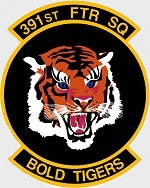JC Wings JCW72F15028 USAF Boeing F-15E Strike Eagle Multi-Role Fighter - 391st Fighter Squadron "Bold Tigers", 366th Fighter Wing, Operation Enduring Freedom, 2001 [Low-Vis Scheme] (1:72 Scale)
"Obsolete weapons do not deter."
- British Prime Minister Margaret Thatcher
 The McDonnell Douglas (now Boeing) F-15E Strike Eagle is an all-weather multirole fighter, derived from the McDonnell Douglas F-15 Eagle. The F-15E was designed in the 1980s for long-range, high speed interdiction without relying on escort or electronic warfare aircraft. United States Air Force (USAF) F-15E Strike Eagles can be distinguished from other U.S. Eagle variants by darker camouflage and conformal fuel tanks mounted along the engine intakes.
The McDonnell Douglas (now Boeing) F-15E Strike Eagle is an all-weather multirole fighter, derived from the McDonnell Douglas F-15 Eagle. The F-15E was designed in the 1980s for long-range, high speed interdiction without relying on escort or electronic warfare aircraft. United States Air Force (USAF) F-15E Strike Eagles can be distinguished from other U.S. Eagle variants by darker camouflage and conformal fuel tanks mounted along the engine intakes.
The Strike Eagle has been deployed in Operation Desert Storm, Operation Allied Force, Operation Enduring Freedom, and Operation Odyssey Dawn carrying out deep strikes against high-value targets, combat air patrols, and providing close air support for coalition troops. It has also seen action in later conflicts and has been exported to several countries.
The F-15E will be upgraded with the Raytheon APG-82 Active Electronically Scanned Array (AESA) radar after 2007, and the first test radar was delivered to Boeing in 2010. It combines the processor of the APG-79 used on the F/A-18E/F Super Hornet with the antenna of the APG-63(V)3 AESA being fitted on the F-15C. The new radar upgrade is to be part of the F-15E Radar Modernization Program. The new radar was named APG-63(V)4 until it received the APG-82 designation in 2009. The RMP also includes a wideband radome (to allow the AESA to operate on more radar frequencies), and improvements to the environment control and electronic warfare systems.
While some of the F-15C/Ds have been replaced by the F-22 Raptor, there is no slated replacement for the F-15E in its primary "deep strike" mission profile. The Strike Eagle is a more recent variant of the F-15, and has a sturdier airframe rated for twice the lifetime of earlier variants. The F-15Es are expected to remain in service past 2025. The USAF has pursued the Next-Generation Bomber, a medium bomber concept which could take over the Strike Eagle's "deep strike" profile. The F-35A Lightning II is projected to eventually replace many other attack aircraft such as the F-16 Fighting Falcon and A-10 Thunderbolt II, and may also take over much of the F-15E's role; however, the F-15E has better combat range under payload.
Pictured here is a stunning 1:72 scale diecast replica of a F-15E Strike Eagle that was attached to the 391st Fighter Squadron "Bold Tigers", 366th Fighter Wing, then participating in Operation Enduring Freedom during 2001.
Now in stock!
Dimensions:
Wingspan: 7-inches
Length: 10-1/2-inches
Release Date: July 2024
 Historical Account: "Fortune Favors the Bold" - The 366th Fighter Wing (366 FW) is a fighter wing of the United States Air Force Air Combat Command stationed at Mountain Home Air Force Base, Idaho.
Historical Account: "Fortune Favors the Bold" - The 366th Fighter Wing (366 FW) is a fighter wing of the United States Air Force Air Combat Command stationed at Mountain Home Air Force Base, Idaho.
The wing is home to three fighter squadrons: the 389th Fighter Squadron and 391st Fighter Squadron flying the F-15E Strike Eagle aircraft and the 428th Fighter Squadron which flies the Republic of Singapore Air Force F-15F (aka F-15SG). Until September 2010, a fourth squadron, the 390th Fighter Squadron flew the F-15C Eagle in an air superiority mission. The 417th Tactical Fighter Squadron which flew F-4D Phantoms and later F-111's. In September 2010 the redesignated 390th Electronic Combat Squadron assumed the mission of the 388th Electronic Combat Squadron and its F-15C/D aircraft redistributed to other F-15 units pursuant to a 2005 BRAC decision.
The 726th Air Control Squadron assigned here gives an air picture to the aircraft as they train. This is a mobile radar unit that routinely deploys to various theaters to operate command and control functions. Structured as a Control and Reporting Center, able to accommodate Control and Reporting Post function. Air Weapons Controller personnel often deploy without home-system to support flying units in various scenarios and exercises throughout the U.S. and European theater. An active Air National Guard unit, the 266th Range Squadron, controls and maintains emitter sites within the 7,412-square-mile (19,200 km2) operational training range located in southern Idaho.
Additionally, the 390th Electronic Combat Squadron, located at Naval Air Station Whidbey Island, Washington, is assigned to the 366th Operations Group. The squadron, consisting of USAF flight crews flying U.S. Navy EA-6B Prowler and EA-18G Growler aircraft, is responsible for suppression of enemy air defenses in support of expeditionary aircraft and ground troops by disrupting enemy electronic activity and obtaining tactical electronic intelligence.


